Over the last 5 years or so, there’s been a definite movement away from traditional steady state cardiovascular exercise in the fitness community. As a result, like almost everything health and fitness related, there’s divided opinion on whether it’s any good for you and if it is, what it’s good for.
In order to assess cardiovascular (CV) exercise’s effectiveness, you need to first determine what it represents and then determine the objective of doing it.
To make this simpler, the following list defines the main forms of exercise considered as cardio and the subsequent list provides the main reasons for people doing them.
Types of ‘cardio’
- Machine based – treadmills, cross trainers, etc.
- Free – Running on a track, outdoors, cycling, etc.
- Group Exercise
- Metabolic Resistance Training (MRT) – A sequence of exercises using resistance (typically weights) designed to maximise calorific expenditure and CV adaptations
Objectives of CV Exercise
- Improve cardiovascular fitness
- Improve body composition
- Improve athletic conditioning
- Improve lactic acid tolerance
- Get moving
- Feel like you’re doing something while disengaging mentally
Most people will go through the first list and agreed with most of what’s on there. The second list however, is normally fine until people reach the last two points. For those in the fitter percentage of the population, it can be easy to forget that for some people, just doing something is significantly better than doing nothing. Some people just want/need to get started, others just want something to take their mind off life.
So with that in mind, the following information provides a breakdown of the individual types of CV exercise and how each meets the different objectives one might have for doing it.
Machine-based Steady State
This definitely improves CV fitness, although it tends to be specific to the activity being performed. I.e. you’ll get better at steady state exercise, but the improvement won’t necessarily correspond to your interval based fitness or activity on another piece of equipment. So getting better at running on a treadmill won’t make you better on the rower.
As for body composition benefits, if you want to get leaner, you need to address your nutrition. That said if your nutrition is good and you’ve got limited sugar in your diet, CV is probably a comfortable way to increase your calorie expenditure for the day. In elite endurance athletes, there may be some benefit to training on a rower or turbo trainer, but athletic conditioning involves small muscle groups that simply don’t fire as actively on machines. Therefore this type of CV may be a worthwhile addition to an athletes conditioning program, but it shouldn’t form the majority of it.
When it comes to getting people moving, machine based steady state training really comes into its own. It has low barriers to entry, requires very little skill and is easy to get started on. If a sedentary individual needs to become more active safely it’s a great place to start. However, once adherence is established they should ideally start to progress their efforts.
The other advantage of the low skill requirement is that people’s minds are free to switch to other things, so it’s also great for ‘switching off’.
It’s also worth noting that most machines don’t have the same muscle recruitment patterns as their ‘free’ counterparts, so there are limits to the carryover to those activities.
Free
‘Free’ CV exercise has most of the same qualities and characteristics as its machine based counterpart. The main differences are in the additional demands that unrestricted and undefined movement place on the body.
Group Exercise
Because of the sheer volume and variety of classes available, as well as the scope of ability of the people participating in those classes, it can be difficult to quantify this type of exercise accurately. Blast fx for example has a high calorie demand if done well. As a general rule of thumb, if you find yourself breathless regularly during the course of a particular class, as a result of the activity involved, you’ll probably get fitter as a result.
If a class is going to do anything for your physique, conditioning or endurance, you should notice it within a couple of months. If you haven’t noticed any improvements in that time, pick something else.
For some people, having someone tell them what to do is just the opportunity they need to switch off mentally. The best course of action is to try a number of different types of classes with a number of different instructors until you find one that’s a fit for you.
Metabolic Resistance Training
There’s a reason that this type of training has become so popular in recent years. The deliberately high energy demands of metabolic training, coupled with the variability in muscle group recruitment, means your body adapts quicker and you become fitter.
For people with a reasonable level of fitness and a good work capacity, this is a great way of maximising calorie burning and creating a serious energy debt in the body.
In spite of the above benefits, this type of ‘cardio’ probably isn’t best suited to many newcomers. As many people know, newcomers make a significant amount of progress in their first 4-6 weeks. If that’s the case, why run yourself into the ground to achieve it? It’s far better to build the habit of exercising gradually, than go for gold from the outset. From a scientific perspective, their technique and muscle fibre recruitment won’t be optimal either. That means beginners will be working incredibly hard and wearing themselves out, but because their central nervous system hasn’t learnt how to recruit muscle fibres effectively, they’ll potentially use less energy. That obviously represents the absolute opposite of the goal.
Whilst you can’t switch off doing this type of training, it can allow you to change what you’re focused on.
So with all of the above in mind, what does that mean for you?
- If you’re a beginner or getting back into exercise after some time off, it doesn’t matter too much what you do, as long as you push yourself just outside your comfort zone.
- If you’re a beginner, CV machines offer the lowest barriers to getting started, but you’ll probably want to mix things up once you’re comfortable
- Group Exercise is a great way of passing responsibility for your workout to someone else, but it’s worth trying a number of classes to find the one that works best for you.
- Metabolic Resistance Training is possibly the best way to improve cardiovascular fitness, whilst preserving strength and lean tissue. Which means for anyone looking to lose fat or prevent fat gain and get stronger, it’s ideal.
- Metabolic Resistance Training is rarely suitable for beginners due to possible technique issues and the fact that it can be unnecessarily challenging if done properly when first starting to exercise.

